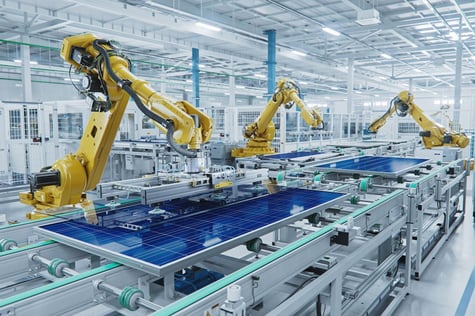Industry 4.0, or the fourth industrial revolution, describes the widespread shift towards intelligent computer systems that enhance operational efficiency. A key aspect of this shift for businesses is the wireless capabilities of IIoT networks to provide businesses with the interoperability of different devices.
That said, IIoT networks present a number of new challenges for businesses to overcome in the form of security, reliability and device design limitations. Fortunately, intelligent antenna integration can help solve these challenges and future proof devices moving forward in industry 4.0.
The fourth industrial revolution
The rapid growth in technology over the last few decades has led to a dramatic shift in how both consumers and businesses interact with it. The fourth industrial revolution is what describes this dramatic shift, with intelligent computer systems becoming commonplace in every industrial sector and aspect of customer life.
In terms of the industrial aspect specifically, this revolution has prioritised the use of technology to optimise, automate and enhance operational efficiency across sectors. Industry Internet of Things (IIoT) provides these features through the wireless interoperability of different devices to enable a heterogeneous process to operate holistically.
For industries such as manufacturing, agriculture and health, IIoT brings significant enhancements to operational efficiency via the connectivity of individual devices. A variety of sensors and devices can communicate vital data points such as temperature, humidity, product quality/quantity and more. The IIoT network then provides the groundwork for these devices to communicate with neighbouring technologies, enabling autonomous productions that greatly enhance operational efficiency.
The challenges of IIoT implementation
The benefits and features of IIoT networks and devices make their implementation seem like a no-brainer. But like most advanced and modern technologies, there are a number of challenges and hurdles to overcome before autonomous and efficient operations can be achieved.
- Security - Compared to consumer-grade IoT networks, IIoT presents far greater security risks for businesses due to the transfer of sensitive data that can potentially be intercepted. These networks are also complex with limited data rates, making it near impossible to integrate traditional security processes.
- Connectivity and reliability - Industrial processes that utilise IIoT networks rely upon their connectivity to maintain optimisation, avoid risks and production interruptions. Reliable networks can become a challenge with highly dense devices and nodes; in this context, an entire network is as strong as its weakest individual device.
- Device design limitations - Due to the specific and specialised nature of IIoT networks, they have strict demands in terms of individual design features. Power efficiency, compact size, reliable performance and low latency are key requirements for IIoT sensors, and as such can lead to limitations to design.
Future-proofing devices with intelligent antenna integration
The challenges and limitations of individual IIoT devices as a result of their network can be overcome with intelligent and suitable antenna integration. As the most power hungry component, implementing the right antenna can not only maintain long-term and reliable operation, but can enhance security and connectivity through specific features.
For security, directional antennas provide enhanced security as well as connectivity via concentrated radio signals that are difficult to intercept. For size, FPC antennas support compact designs through the ability to be placed on the device housing rather than the PCB. Moreover, the ground plane is found on the antenna itself, which means that energy efficiency and performance is maintained. And for the devices that do have spare PCB space, compact SMD antennas can fit to provide optimal performance, reliability and connectivity.
All in all, antenna integration offers unique advantages to different IIoT devices that can not only ensure a high level of productivity, but future-proof the devices and networks moving forward in industry 4.0.
Integrate the perfect antenna for your IIoT device with Antenova
Industry 4.0 has made waves across industries, increasing the reliance on the interoperability of devices to enhance operational efficiency. IIoT networks act as the foundation for this interoperability, and intelligent antenna integration paves the way to futureproof and strengthen this foundation.
At Antenova, we provide a wide array of high-performance antennas that come in a variety of types, shapes and sizes. No matter your design or specific IIoT application, our team of professionals can help you integrate the perfect antenna solution that doesn’t compromise on any feature. If you need power efficiency, performance, compact size or each of the above, we can provide you with the right solution for your device.
To find out more about our wide range of high performance and efficiency antennas, contact a member of our team today




